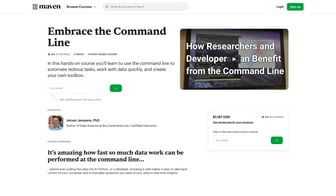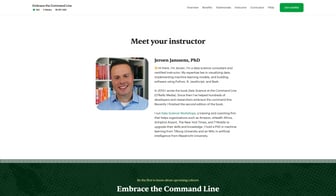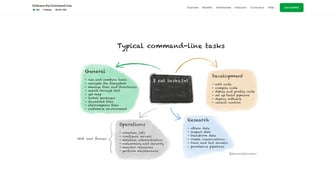Archive of My Online Course Embrace the Command Line

Mar 23, 2023 • 17 min read.
Embrace the Command Line was a three-week cohort-based course, created to help developers and researchers getting started with the command line. It was roughly based on my book Data Science at the Command Line.
I had the pleasure of running the course twice in 2022, with students from all over the world. During the course, I really got to know the students and their situation, allowing me to better help them. Both times were rewarding yet time consuming.
It was scheduled for a third time in April 2023, but because I joined Xomnia as a full-time employee at the beginning of the year, I didn’t have enough time left and needed to cancel it, unfortunately. I’m not sure whether I’ll be able to run another cohort. If you and your colleagues are interested we could talk about organizing an incompany training.
The course was hosted on Maven, which provides many great tools to manage the course material, keep in touch with (potential) students, and organize online sessions. I participated in their rather excellent bootcamp, which really helped me to think about the course structure and write the landing page.
Should the landing page go down, below is most of the copy together with a few screenshots for archival purposes. The video shown in the first screenshot, How Researchers and Developers Can Benefit from the Command Line, can be watched on YouTube: https://www.youtube.com/watch?v=0XI8FPVnNzY.
– Jeroen

In this hands-on course you’ll learn to use the command line to automate tedious tasks, work with data quickly, and create your own toolbox.
It’s amazing how fast so much data work can be performed at the command line before ever pulling the data into R, Python, or a database. Knowing it well makes it easy to take back control of your computer and to translate questions you have of your data to real-time insights.

This course is for you if… You’re a developer looking to streamline your workflow and take back control over your computer. You’re a researcher looking to become more efficient and productive at working with data. You feel intimidated by the power of the command line but understand the benefits it brings.
Key outcomes
A new way of working: Run and string together small but powerful tools to accomplish and automate tedious tasks. Integrate seamlessly with your existing workflow.
Be more efficient: Parallelize and distribute your data-intensive or compute-heavy tasks to multiple cores and machines.
Data science skills: Easily obtain, inspect, transform, and visualize data coming from various sources (including APIs, server logs, spreadsheets, and databases).
Build your own toolbox: Turn ad-hoc commands into reusable command-line tools and even convert your existing code (including Python, R, and JavaScript) to create your own tools.
Hands-on experience: We’re actually going to get our hands dirty in this course. Through workshops and exercises you’ll quickly become comfortable working at the command line.
Be part of a great community: You’re not alone in this. You’ll surround yourself with like-minded people who want to grow alongside you.
Solid foundation: It’s impossible to cover everything the command-line has to offer. Instead, I’ll make sure you know how to keep on learning after the course.

The command line is a powerful piece of technology available on Windows, macOS, and Linux.
The Unix or Linux command line, sometimes referred to as the shell or the terminal, is as powerful as it is intimidating. By typing commands, you can rename thousands of files, process large amounts of data, and work on remote machines with ease. But make one mistake and everything will explode!
At least, that’s what many think when they first encounter this stark and unforgiving environment. I can’t blame them, the command line just doesn’t look very inviting. Still, the fact remains that the command line successfully enables thousands of developers and researchers to be more efficient and productive at work. All they had to do is embrace it.
In this three-week cohort based course, I’ll help you embrace the command line so you can also become more efficient and productive.

Great workshop! Very well done and very useful information delivered in an excellent and interactive manner. Jeroen anticipated very well on the different knowledge levels within the group. I would highly recommend this course to anyone that is interested kickstarting their command-line experiences.
As a seasoned UNIX command line adept, I didn’t expect to learn much. I was wrong! Over the years, many new tools have become available that I didn’t know about, and that can be combined with traditional tools in new ways. I have been able to simplify and improve the efficiency of many of the scripts I use on a daily basis.
Besides demonstrating a good knowledge and experience in command-line tools for data science, Jeroen had very good training skills, clear communication, and managed to adapt the level of the training to the level of the audience, which is not always easy!
I found Jeroen to be a wonderfully welcoming, knowledgeable, and patient instructor. He covered content at a very nice pace, and made the workshop feel like a welcoming space where any question was fair game. Thanks to our small class, I really appreciated how he took interest in what each participant wanted to get out of the class.
Jeroen is a great coach. Because he is able to tailor the course to the business challenges of the participants, the learning curve goes straight up! Jeroen quickly switches to the knowledge level of the participants, so that everyone is guided in a tailored manner.
This training was very enlightening. I discovered that most of our tasks could be achieved using simple tools, without the need for heavyweight & complex software. This training not only got me data science skills with simple tools, but I also felt very confident as a command-line power user.

Meet your instructor Jeroen Janssens, PhD
Hi there, I’m Jeroen. I’m a data science consultant and certified instructor. My expertise lies in visualizing data, implementing machine learning models, and building software using Python, R, JavaScript, and Bash.
In 2014 I wrote the book Data Science at the Command Line (O’Reilly Media). Since then I’ve helped hundreds of developers and researchers embrace the command line. Recently I finished the second edition of the book.
I run Data Science Workshops, a training and coaching firm that helps organizations such as Amazon, eHealth Africa, Schiphol Airport, The New York Times, and T-Mobile to upgrade their skills and knowledge. I hold a PhD in machine learning from Tilburg University and an MSc in artificial intelligence from Maastricht University.

Designed for both researchers and developers. While my book is aimed at data scientists only, this course will give you command-line knowledge and skills that are useful for doing research and developing software.
Absolutely hands-on. It’s one thing to read a book. To try it for yourself is a different story. During the live sessions, you’ll get hands-on experience in a safe environment, making you well prepared.
Taught by an experienced, certified instructor. I’ve trained and coached hundreds of students in the past eight years. My approach is practical and casual, but also sustainable. I’ll be able to give you the personal attention you need.
More fun and effective. Because you’ll be embracing the command line with other researchers and developers. You’ll be part of a welcoming community of like-minded people.

Course syllabus
01 Essential concepts of the command line: Run command-line tools; Combine command-line tools; Redirect input and output; Work with files and directories; Get help.
02 Making the Command Line Less Scary: Customizing your prompt and environment; Creating aliases for rm and mv; Setting up a “recycle bin”.
03 Obtaining Data: Download files and data; Import spreadsheets; Query databases; Call RESTful APIs.
04 Parallel processing: Introducing GNU parallel; Looping over files and lines; Logging and output; Distributed processing.
05 Working with Text: Data Search through text; Extract values; Clean up messy data.
06 Working with JSON: Data Introducing jq; Reformat; Extract values; Convert to CSV.
07 Working with CSV: Data Introducing xsv; Select rows and columns; Run SQL queries on CSV.
08 Editing Files: The basics cat and echo; Introducing nano; What about vim and emacs?
09 Creating Command-line tools: From Bash; From Python; From R.
10 Exploring Data: Inspect data quickly; Create visualizations; Viewing images on the command line.
11 Automating Things: Set up build pipeline; Deploy software; Make analyses reproducible.
12 Version Control: Introducing Git and GitHub; Staging and committing; Branching and merging; Pulling and pushing.

Frequently Asked Questions
Do I need to have experience with the command line? You don’t need to have any experience with the command line, Unix/Linux, or even programming.
We’ll start at the beginning and steadily go into more advanced topics. The only prerequisites are a computer and the willingness to learn!
Will I be able to do this next to my regular job? Absolutely. I have designed this course such that you can do this next to a full-time job. In fact, nearly all of the people who have already signed up have a full-time job.
When will live sessions be held? 6 two-hour live sessions will take place over a period of three weeks on each Monday and Thursday at 11:00 PDT / 14:00 EDT / 18:00 UTC / 20:00 CEST. You’ll receive calendar invites for all sessions once you’ve signed up.
Do I have to attend all of the live sessions? It’s okay if you have to miss a session or two. Every live session is recorded and made available for you to replay, at your convenience. With that said, I strongly recommend you make time for them so you can ask questions directly to me and join productive breakout discussions.
Is there a community to interact with others? Yes! We’ve created a private community space for students of the Embrace the Command Line course. There you can share your progress, get feedback, ask for help, and more.
Is this course also available as a corporate training? If you have a couple of colleagues who are interested in this topic, then an in-company training might be worthwhile. Visit my company Data Science Workshops for more information.
Would you like to receive an email whenever I have a new blog post, organize an event, or have an important announcement to make? Sign up to my newsletter: